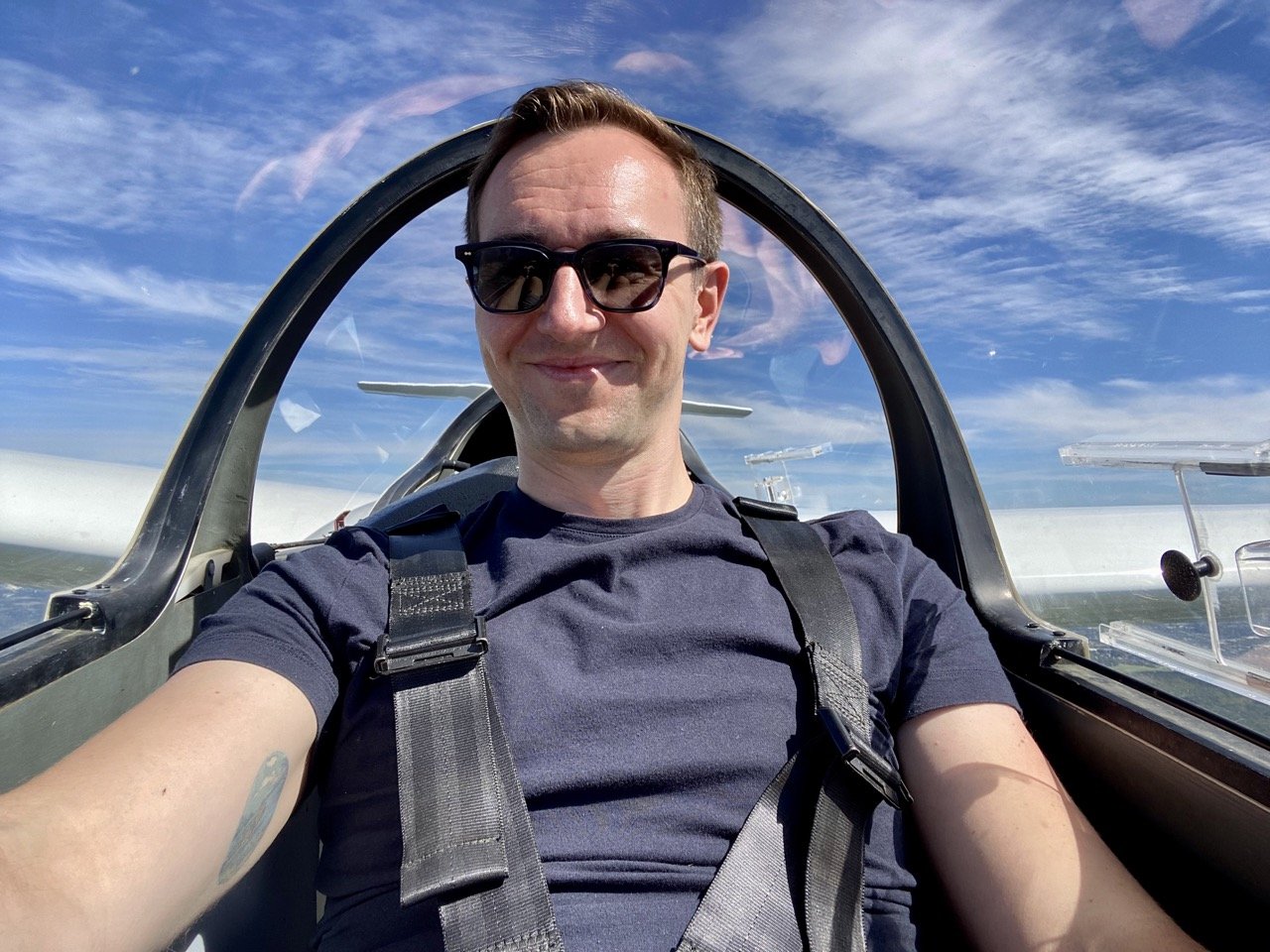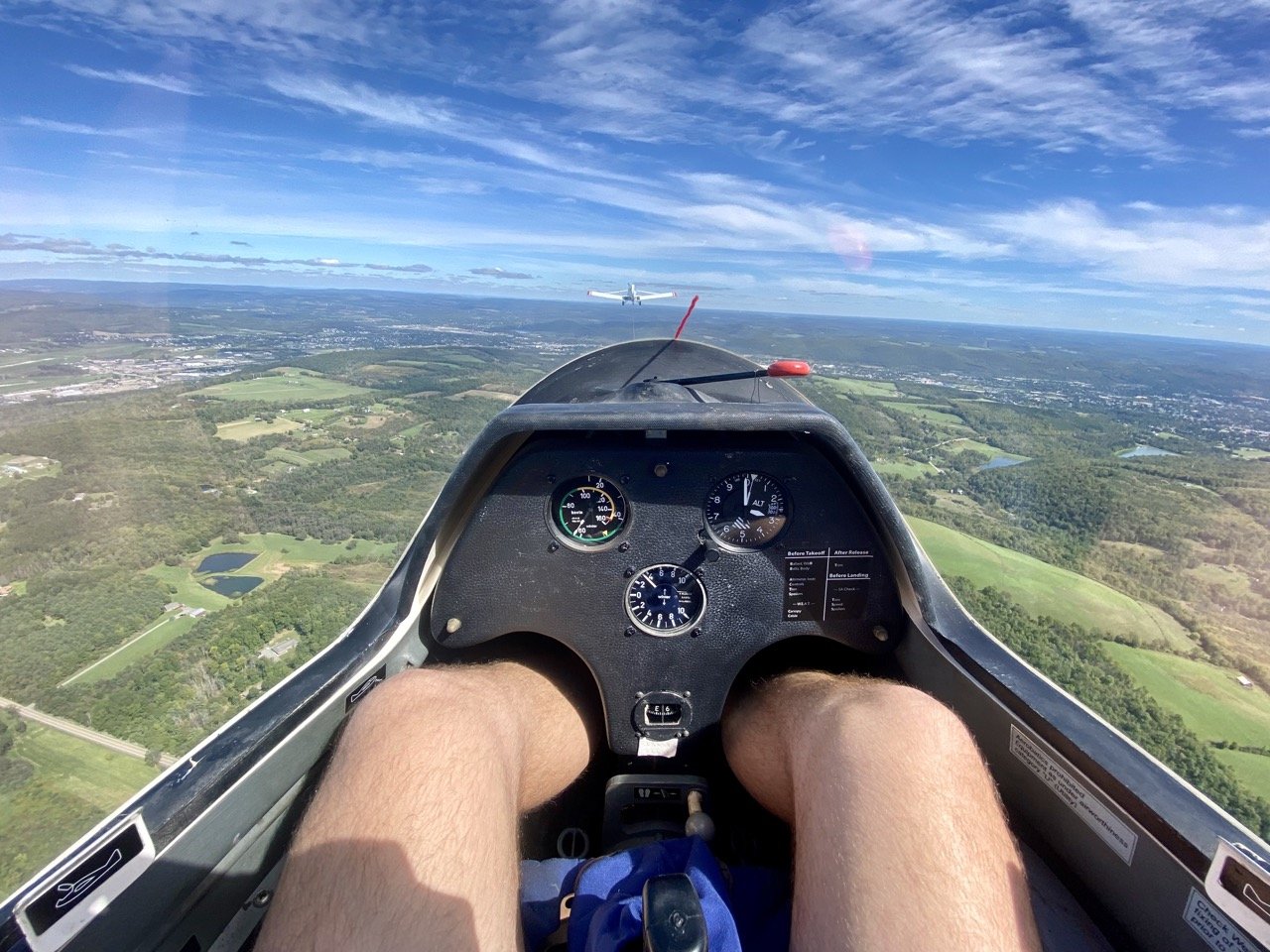Harris Hill Soaring: Visiting One of the Oldest and Largest Glider Clubs in America
Harris Hill Soaring, located in Elmira, New York is the epicentre of soaring in America. When you dig beneath the surface though, you realize it’s about more about just gliding - it’s about community, empowerment, and helping people realize their dreams.
A glider getting ready for takeoff
There’s a feeling of community and support that permeates Harris Hill Soaring.
From a tourism lens, yes they offer unforgettable rides to the public above the skies of Elmira, New York, with views extending across the Finger Lakes region. However, what struck me was how many members I talked to that explained to me how much Harris Hill Soaring had offered them in their lives, how it had changed their lives, and how they were hoping to pay it back.
I stood on the runway beside some of the instructors watching gliders being towed high into the sky, and they pointed me over to a car sat right next to the runway. They were pointing to a locally revered man in his 80s, affectionately known as “Corky.” He was a former Air Force pilot who shows up many days, just to help things flow along, and to offer his insight.
At its core, this place is a treasure trove of knowledge sharing. There’s a reverence and respect for those who have flown, and a dedication to help others do much the same.
While some people aim to use this place as a pedestal to achieve their pilot dreams, you can always simply just come up here for a ride, and meet some of these pilots in the literal best way possible. I had a whole new appreciation for this program once I saw the pilots in action, so knowledgeable and in control.
Harris Hill Soaring, in the end, is a place for everyone.
A Brief History of Harris Hill - America’s Soaring Capital
It’s not a coincidence that you’ll find the National Soaring Museum on the grounds of Harris Hill. The first 13 national soaring contests were held here between 1930 - 1946.
That’s for good reason. The updraft from the ridge of the Chemung River Valley makes it an ideal environment for a glider flight, and the stunning scenery certainly doesn’t hurt either, I may add.
Mark Twain Country, the local tourism board also notes:
“Several other factors also contribute to the area being central to the history of soaring. Schweizer Aircraft Corp. which produced half of all American-built sailplanes, was located at the bottom of Harris Hill. Additionally, at the outbreak of WWII, Elmira was the first site chosen to develop a glider program and train pilots for the war effort.”
This history means that Harris Hill very much sees itself as the epicentre for the appreciation and development of soaring in America. Their mission statement doesn’t mince words. They want to “advance soaring through demonstration, education, and competition.”
What to Know About Rides at This American Soaring Mecca
The first thing to note here for those interested in heading up into the skies is that they are a seasonal operation, meaning they close each year for the winter.
Even in the warmer months, rides are going to be weather permitting, so please note that if your flight is cancelled, it’s for good reason, and safety is at the forefront of what they do here.
Here are some key details:
There’s no age limit for a ride here. Mike Goldstein, a Professor at Cornell and passionate member and volunteer, summed things up well when he told me that “today alone we’ve had a 10 year old and a 94 year old.” Don’t you just have to love that?
They fly with the ASK-21 High Performance Glider. It’s a two-seat plan which means there are two riders on each flight (the pilot and the passenger). The wraparound canopy means you’ve got sweeping views, and you can capture some jaw-dropping footage in the air. I created a video on my Instagram account if you want to see just what I mean by that. You wouldn’t believe how quiet it is up there. That’s part of what makes soaring so serene.
Flights typically last around 15-20 minutes. You’ll be towed off the runway and into the air, then you’re left to enjoy the skies around the 4000 feet above sea level mark. If you look carefully, you’ll be able to see Corning, Watkins Glen State Park, and a lot of what makes the Finger Lakes region oh so special.
Any season is a good season for soaring (minus winter, naturally), but the rides tend to be particularly popular in late September and October because of the fall foliage.
The passenger weight limit is 245 pounds.
Flights, at the time of writing, cost right around $150 (though there is some customization you can do, weather permitting, to go higher up, and thus have a longer flight). By the way, it’s a non-profit organization, so a lot of their income is used to help subsidize flying hours for young learners and so forth.
They don’t take reservations since all of their employees are volunteers, and with no-shows and changing weather and the like, they feel it’s too hard to have things set in stone for them. The best thing to do is to arrive, add your name to the list, and you can hang around for a while, watching the flights depart, and perhaps popping into the museum. To be safe, assume you may be waiting an hour or so, but know it’s not a painful wait by any means. It’s fun to be there, around all the action. They note that it’s often best to show up early and even “be there when they open at 10am.”
While I was in flight with my expert pilot, Evan Kownurko, he was pointing out how he was using the wind to our advantage and dropping little tidbits that helped me appreciate the soaring experience. For one, he noted how birds weren’t scared away from the glider because it was dead silent, and that allows you to get up close and personal with hawks and the like.
I felt utterly safe as a passenger in his plane, because I understood how much training he’d gone through to get to that point.
Training and Membership
I spent a fair bit of time when I first arrived talking to former members. One such member was Todd Knapp who mentioned that, growing up, Harris Hill Soaring was a home away from home for him.
“If you had a love for aviation, this place was it,” he noted.
A lot of kids end up becoming pilots because of the start they get here. Todd aims to be a pilot next year.
“Harris Hill has a club atmosphere, with a history behind it, and with people from all different backgrounds, with rides being subsidized for those who can’t afford it. I started working 4 hours for a 12 dollar credit, and each flight was only 3 bucks.”
When I later talked to Mike again, he proudly noted:
“…these kids think they’re learning how to fly. But they’re learning about a lot more than that.”
You can actually start flying at just 14 years of age, before you can even get your driver’s permit.
If you’re interested in membership, your best bet is to head to their training page, to read more about their programs, and to download a membership application, but I’ll summarize a bit of what you should know below first.
For Adults
Once you join, you’ll start flying right away with instructors. You only pay for the flight cost since the teachers are volunteers.
You need to fly at least 35-65 hours in order to be proficient enough to solo. Another 10-15 more, and you’ll then typically take your flight test with a FAA examiner.
Education is a big part of it, so you’ll be learning about weather, the forces that keep you aloft, and how to handle a glider.
They do their best to hold flying sessions after normal work hours so that you can balance work and this exciting hobby.
The expectation is that when you become a club member, you’ll sign up for 4 hour duty shifts (1-2 per month) to help out around Harris Hill Soaring.
If you’re already a private pilot, you don’t need to take a written test or offer a third-class medical certificate to transition.
It’s worth noting that “HHSC is as much a social gathering as a flying club and the people in the club are great fun to be around. You all share a common passion – soaring, and the depth and breadth of experience is substantial. Don’t be afraid to say hello, ask a question, join in, and especially attend our social events. We WANT new members to become lifelong members.”
The Junior Program
Evan (who started in the junior program) and I before our ride.
The Harris Hill juniors program is arguably the top in the country, partially because they fly at such a substantially reduced cost, which allows juniors to build up hours very quickly.
Teens can join at 14 (or 13 if their parents are a member).
They are expected to work the flight line, help with events, and generally be a positive part of the community.
Junior program members can earn their private pilot license at age 16.
Solos will only be granted when instructors have worked with a member carefully and feel they are ready.
Basically, this is an ideal starting point for a career in aviation for young folks. When Mike and I were walking the grounds, I was captured by the enthusiasm he had for the young pilots here.
“This is the most accessible way to learn to fly. We have one pilot who just won two national championships who started here young. More than one flier who was selected for the worlds. We’re ground zero for flying in the US. Our students don’t realize how good they are, and will be.”
The National Soaring Museum
The National Soaring Museum is, fittingly, not far away at all from the Harris Hill runway. Their goal is simple - to preserve the important history and work surrounding motorless flight. They’re open most days of the year, but do tend to close Monday and Tuesday in the winter months.
If you’re not a member, it’s about $10 to enter (5 bucks for youth, and 6 and under free). If you are a member, it is free, as you might imagine.
They have a large collection of gliders dating all the way back to 1890. They’ve got 80 gliders in their collection, and the most unique and prominent of those tend to be on permanent display.
There’s Only One Harris Hill
I have a penchant for writing about places that are one-of-a-kind, and that’s the case here with Harris Hill due to their long history, and their current programming.
When we were walking around one of the hangers, looking at old planes, I asked Mike what he felt my readers needed to know - what the big takeaway was about Harris Hill.
Without a moment’s hesitation, he looked me the eyes and said, “well, this was the centre of the soaring world, Chris. And, in many ways, it still is.”
I want to humbly thank Madden Media & Harris Hill Soaring for hosting me as media. All opinions are completely my own.
If you appreciated this article, you’ll love our newsletter, as well as our Facebook group! Feel free to join, just like the Rochester Fringe all are welcome.






